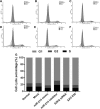MiR-214 Regulates the Human Hair Follicle Stem Cell Proliferation and Differentiation by Targeting EZH2 and Wnt/β-Catenin Signaling Way In Vitro
- PMID: 30603559
- PMCID: PMC6171681
- DOI: 10.1007/s13770-018-0118-x
MiR-214 Regulates the Human Hair Follicle Stem Cell Proliferation and Differentiation by Targeting EZH2 and Wnt/β-Catenin Signaling Way In Vitro
Abstract
miR-214 plays a major role in the self-renewal of skin tissue. However, whether miR-214 regulates the proliferation and differentiation of human hair follicle stem cells (HFSCs) is unknown. Primary HFSCs were isolated from human scalp skin tissue, cultured, and identified using flow cytometry. An miR-214 mimic and inhibitor were constructed for transfection into HFSCs. The MTS and colony formation assays examined cell proliferation. Immunofluorescence detected the localization and expression levels of TCF4, β-catenin, and differentiation markers. Luciferase reporter and TOP/FOP Flash assays investigated whether miR-214 targeted EZH2 and regulated the Wnt/β-catenin signaling pathway. Western blot determined the expression levels of enhancer of zeste homolog 2 (EZH2), Wnt/β-catenin signaling-related proteins, and HFSC differentiation markers in cells subjected to miR-214 transfection. miR-214 expression was remarkably decreased during the proliferation and differentiation of HFSCs into transit-amplifying (TA) cells. Downregulation of miR-214 promotes the proliferation and differentiation of HFSCs. Overexpression of miR-214 led to decreased expression of EZH2, β-catenin, and TCF-4, whereas downregulation of miR-214 resulted in increased expression of EZH2, β-catenin, and TCF-4 as well as TA differentiation markers. Immunofluorescence assay revealed that inhibiting miR-214 triggered the entry of β-catenin and TCF-4 into the nucleus. The luciferase reporter and TOP/FOP Flash assays demonstrated that miR-214 directly targets EZH2 and affects Wnt/β-catenin signaling. The miR-214/EZH2/β-catenin axis could be considered a candidate target in tissue engineering and regenerative medicine for HFSCs.
Keywords: EZH2; Hair follicles stem cells; Transit-amplifying cells; Wnt/β-catenin signal; miR-214.
Conflict of interest statement
The authors have no financial conflicts of interest.The study was approved by the Ethical Committee of ChenZhou No.1 People’s Hospital (CZSDYRMYY-2017-18). All the donators signed the informed consent. There are no animal experiments carried out for this article.
Figures






Similar articles
-
EZH2-mediated inhibition of microRNA-22 promotes differentiation of hair follicle stem cells by elevating STK40 expression.Aging (Albany NY). 2020 Jul 12;12(13):12726-12739. doi: 10.18632/aging.103165. Epub 2020 Jul 12. Aging (Albany NY). 2020. PMID: 32657761 Free PMC article.
-
TWEAK regulates the functions of hair follicle stem cells via the Fn14-Wnt/β-catenin-CXCR4 signalling axis.Wound Repair Regen. 2025 May-Jun;33(3):e70032. doi: 10.1111/wrr.70032. Wound Repair Regen. 2025. PMID: 40325995 Free PMC article.
-
EZH2-mediated repression of GSK-3β and TP53 promotes Wnt/β-catenin signaling-dependent cell expansion in cervical carcinoma.Oncotarget. 2016 Jun 14;7(24):36115-36129. doi: 10.18632/oncotarget.8741. Oncotarget. 2016. PMID: 27092879 Free PMC article.
-
Regulation of signaling pathways in hair follicle stem cells.Burns Trauma. 2022 Jul 4;10:tkac022. doi: 10.1093/burnst/tkac022. eCollection 2022. Burns Trauma. 2022. PMID: 35795256 Free PMC article. Review.
-
A systematic summary of survival and death signalling during the life of hair follicle stem cells.Stem Cell Res Ther. 2021 Aug 11;12(1):453. doi: 10.1186/s13287-021-02527-y. Stem Cell Res Ther. 2021. PMID: 34380571 Free PMC article. Review.
Cited by
-
Exosomal Micro RNAs Derived from Dermal Papilla Cells Mediate Hair Follicle Stem Cell Proliferation and Differentiation.Int J Biol Sci. 2019 May 20;15(7):1368-1382. doi: 10.7150/ijbs.33233. eCollection 2019. Int J Biol Sci. 2019. PMID: 31337968 Free PMC article.
-
Expression profile analysis of dermal papilla cells mRNA in response to WNT10B treatment.Exp Ther Med. 2020 Feb;19(2):1017-1023. doi: 10.3892/etm.2019.8287. Epub 2019 Dec 5. Exp Ther Med. 2020. PMID: 32010264 Free PMC article.
-
miR-133a-3p and miR-145-5p co-promote goat hair follicle stem cell differentiation by regulating NANOG and SOX9 expression.Anim Biosci. 2024 Apr;37(4):609-621. doi: 10.5713/ab.23.0348. Epub 2023 Nov 2. Anim Biosci. 2024. PMID: 37946416 Free PMC article.
-
EZH2-mediated inhibition of microRNA-22 promotes differentiation of hair follicle stem cells by elevating STK40 expression.Aging (Albany NY). 2020 Jul 12;12(13):12726-12739. doi: 10.18632/aging.103165. Epub 2020 Jul 12. Aging (Albany NY). 2020. PMID: 32657761 Free PMC article.
-
Stem cell-intrinsic mechanisms regulating adult hair follicle homeostasis.Exp Dermatol. 2021 Apr;30(4):430-447. doi: 10.1111/exd.14251. Epub 2020 Dec 20. Exp Dermatol. 2021. PMID: 33278851 Free PMC article. Review.
References
-
- Díaz-Flores L, Jr, Madrid JF, Gutiérrez R, Varela H, Valladares F, Alvarez-Arguelles H, et al. Adult stem and transit-amplifying cell location. Histol Histopathol. 2006;21:995–1027. - PubMed
LinkOut - more resources
Full Text Sources
